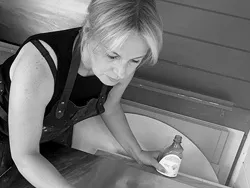

Making the Most of Your Collection: Lighting
by Deanna Dawkins / Wednesday 9th of December, 2015
When considering where to hang a painting, the most obvious factor is perhaps the painting’s size. But an equally important, and often overlooked, factor to consider is lighting.
There is first the practical consideration. Though much more durable than a print, watercolour or photograph, oil and acrylic paintings can nonetheless be vulnerable to light damage over extended periods of time. For this reason, it is important to consider the amount and extent of any UV light exposure your painting will receive. Will the painting be in direct sunlight? How many hours a day will it be exposed for? Will it be exposed to any damaging artificial light? Naturally, a new painting will not immediately demand the same considerations as an antique one; but by taking preventative measures from the start, you can help to extend the lifetime of your painting for generations.
Secondly, there is of course the matter of aesthetics. In what kind of lighting does your painting simply look the best? Does your painting appear better in daylight or does it glow in lamplight? Could it benefit from a picture light? Before permanently hanging your painting, it is certainly worth first exploring what sort of lighting best suits your painting. For example, take the above painting by Edward Hersey, ‘Home at Last’. While obviously impressive in daylight, it positively comes to life when complemented with a picture light in the lower lighting of evening.
There of course must be a balance between these practical and aesthetic considerations. After all, locking your painting away in a dark room will hardly yield much enjoyment. But by giving careful consideration to the lighting of your painting, you can help to preserve your painting and ensure that it is displayed at its full potential.
Here are a few suggestions to get you started:
-
Carry your painting around the home at various times of day to see what type and amount of light is the most flattering before hanging permanently.
-
If your painting will be exposed to a picture light or other artificial lighting, consider using LED rather than tungsten or fluorescent bulbs, as LED bulbs do not emit UV light.
-
If at all possible, avoid hanging your painting in direct sunlight. Saying this, curtains and blinds can help limit the amount of UV light that reaches your painting.
Further News and Articles


Annie Luke Turner Wins Women in Art Prize
Contemproary artist Annie Luke Turner wins in the Abstract Art category.
Sean Durkin: Art For All! 2025
Proudly announcing our fourth annual solo show by British contemporary artist Sean Durkin.

Meet the Artist Event: Clare Haley
An exciting opportunity to meet Yorkshire artist Clare Haley.
York Fine Arts Celebrates 10 Years of Yorkshire Artist Clare Haley
York Fine Arts unveils its 10th anniversary exhibititon of work by contemporary landscape artist Clare Haley.
Touring Dracula Exhibition to be Laid to Rest at York Fine Arts
Delve into an immersive exhibition, featuring ten original pencil illustrations by York artist and our own Senior Gallery Assistant, Kirsty Maclennan.

Five Fine Art Favourites: Spring 2025
As we burst forth into the spring ahead, we select five pieces from our collection that are currently brightening our days.